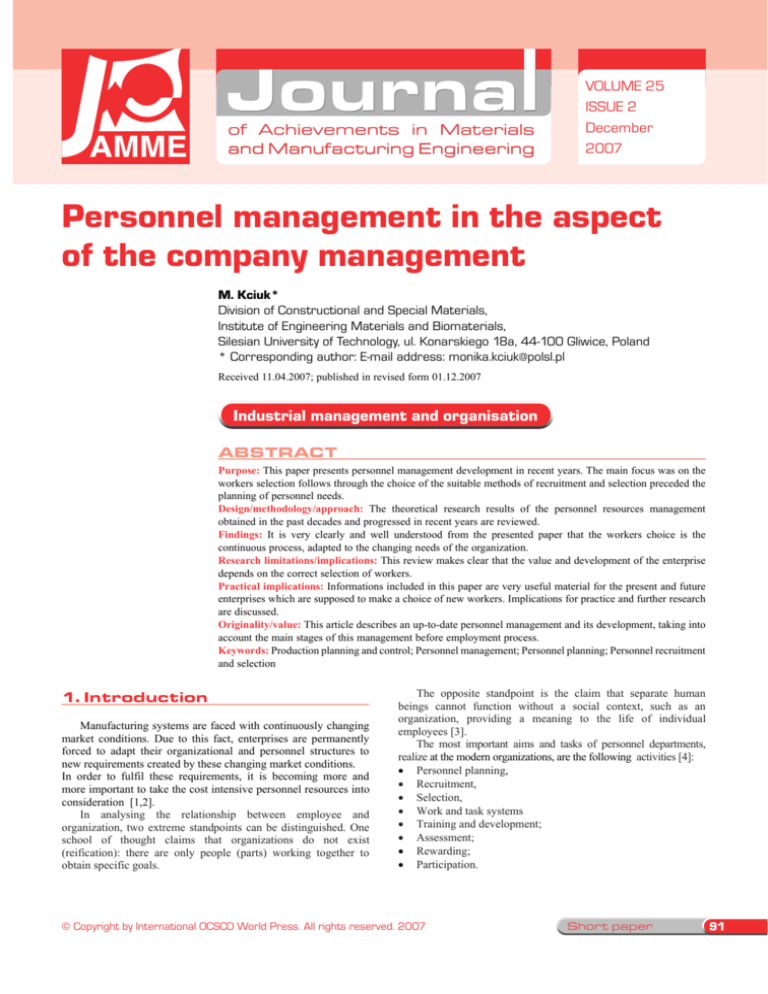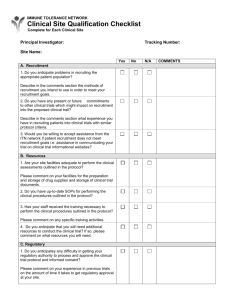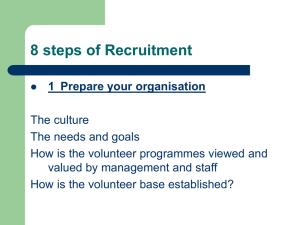
of Achievements in Materials
and Manufacturing Engineering
VOLUME 25
ISSUE 2
December
2007
Personnel management in the aspect
of the company management
M. Kciuk*
Division of Constructional and Special Materials,
Institute of Engineering Materials and Biomaterials,
Silesian University of Technology, ul. Konarskiego 18a, 44-100 Gliwice, Poland
* Corresponding author: E-mail address: monika.kciuk@polsl.pl
Received 11.04.2007; published in revised form 01.12.2007
Industrial management and organisation
Abstract
Purpose: This paper presents personnel management development in recent years. The main focus was on the
workers selection follows through the choice of the suitable methods of recruitment and selection preceded the
planning of personnel needs.
Design/methodology/approach: The theoretical research results of the personnel resources management
obtained in the past decades and progressed in recent years are reviewed.
Findings: It is very clearly and well understood from the presented paper that the workers choice is the
continuous process, adapted to the changing needs of the organization.
Research limitations/implications: This review makes clear that the value and development of the enterprise
depends on the correct selection of workers.
Practical implications: Informations included in this paper are very useful material for the present and future
enterprises which are supposed to make a choice of new workers. Implications for practice and further research
are discussed.
Originality/value: This article describes an up-to-date personnel management and its development, taking into
account the main stages of this management before employment process.
Keywords: Production planning and control; Personnel management; Personnel planning; Personnel recruitment
and selection
1.
Introduction
1. Introduction
Manufacturing systems are faced with continuously changing
market conditions. Due to this fact, enterprises are permanently
forced to adapt their organizational and personnel structures to
new requirements created by these changing market conditions.
In order to fulfil these requirements, it is becoming more and
more important to take the cost intensive personnel resources into
consideration [1,2].
In analysing the relationship between employee and
organization, two extreme standpoints can be distinguished. One
school of thought claims that organizations do not exist
(reification): there are only people (parts) working together to
obtain specific goals.
The opposite standpoint is the claim that separate human
beings cannot function without a social context, such as an
organization, providing a meaning to the life of individual
employees [3].
The most important aims and tasks of personnel departments,
realize at the modern organizations, are the following activities [4]:
x Personnel planning,
x Recruitment,
x Selection,
x Work and task systems
x Training and development;
x Assessment;
x Rewarding;
x Participation.
© Copyright by International OCSCO World Press. All rights reserved. 2007
Short paper
91
Journal of Achievements in Materials and Manufacturing Engineering
2.
Personnel
planning
2. Personnel
planning
The planning which focuses on the prognoses of the future
demand of the organization on workers is first step in the logging of
human supplies both from among already engaged in the enterprise
how and from behind him [5,6].
The frame thanks to conducted recruitment and selection
becomes in the course of the selection appeared person or persons
applying about the work group, fulfilling criteria required by the
institution.
After positive finishing the process of recruitment and selection,
the management of the organization makes the decisions about the
employment.
The planning of human resources consists in the settlement of
the future workings, which aims to undertake for the achievement
the appointed aim. Planning of human supplies answers the strategy
of the organization, defines future structure and the size of the
employment [7,8].
The process of the planning of human supplies defines the level
of personnel needs indispensable to frame and the realization of the
strategy of the management human supplies. This is the process in
which should be consider the present and future requirements in the
face of workers in the relationship with the realization of the
established strategy. The basis of the success of this process is good
employment plan arising from early worked out strategy of the
development (Fig. 1) [9].
The datum-point of the human resources planning is to
determine factors, which influence on that supplies. The internal
factors connected with the firm and external factors resulting from
the surroundings of the organization should be qualified.
Volume 25 Issue 2 December 2007
x
x
x
x
x
x
x
x
Factors connected with the firm are following [10]:
vision, mission and the aims of the activity of the firm;
plans in the range of production and logistics, the
development of technology, marketing and finances;
the organizationalstructure of the enterprise;
thefinancial shape of the enterprise;
thesize and structure of possessed human supplies, according
to such the criteria as: the occupied position of work, lids,
possessed qualifications;
theefficiency of the work;
applied technique and technology;
thetime of the work.
The most important factors connected with surroundings of
the firm [10]:
x situation on the labour market,
x theaccessibility and the information topicality relating to free
places of the work;
x economicsituation;
x position of the firm on the market, her credibility;
x competition of different organizations, in the peculiarity
matters connected with the height of offered pays and the
possibilities of the development of the professional career;
x rate and the directions of the development of used and related
technologies;
x valid law regulations, which contain norms and duties of the
employer in the range of workers employment,
x development of education and education conditioning the
quality of the accessible supplies of the work.
Fig. 1. Process of the personnel planning [9]
92
Short paper
M. Kciuk
Industrial management and organisation
3.
Process
of workers
3. Process
of workers
choice choice
The decision-making about the logging of definite candidates
should be preceded by planning personnel needs. So the balance
of the employment should be made continuously to formulate it,
which allow to estimate the level of the workers usefulness to the
realization of the present and future tasks at the organization [11].
The profile of the position of the work is the point of the exit
of the led correctly process together with indispensable
requirements to its assumption.
The typical description of the position of the work takes into
account the name the positions and connected with it range of
basic duties, authorizations and responsibility, the level of the
education, the level of desirable skills and the special features of
the personality.
Characterizing the position of the work - its place in the
organizational structure and also the conditions of the work
should be qualify.
So the constructed description of the position of the work
serves the possibilities to prepare candidate personal profile.
The guild of personal, places oneself the features and skill
which from the point of the employer sight are for the given
position the most essential in the profile [4].
In the personal profile are placed such features as: the skill of
communicating, the strength of convincing, emotional stability,
initiative. Seeking the candidate to the special kind of works he
also gets under the attention his physical values in many cases.
Recruitment ends with the moment of the preparation of the work
candidates list [11].
The workers choice is the continuous process, adapted to the
changing needs of the organization.
Two stages: recruitment and selection consist on the process
of workers choice [12]. Personnel needs are defined during
recruitment, creates professional profiles and establishes criteria
and the way of the choice. In second stage - the selection – the
candidates final choice is achieved.
The requirements for a selection system are knowledge, skills,
ability, and other characteristics [14]. The selection is sometimes
the long-lasting and complicated process, what represents the
Figure 2 [15].
The goal of personnel selection, as all business processes, is
to ensure an adequate return on investment. In the case of
selection, this entails assurances that the productivity of the new
hires produce more value than the costs of recruiting, selecting,
Fig. 2. Selection diagram [15]
Personnel management in the aspect of the company management
93
Journal of Achievements in Materials and Manufacturing Engineering
and training them. Within industrial psychology, the area of utility
analysis specifically addresses this issue.
Selection is conducted by specify methods (social and
psychological measurements) [13].
Examples include the use of minimum or desired
qualifications, resume/application review, scored biodata
instruments, oral interviews, work performance measures (e.g.,
writing samples), and tests (cognitive ability, personality, job
knowledge).
The process ends making the decision about employment and
signature of the contract.
4.Conclusions
4. Conclusions
Dynamic changes proceeded in the world, the development of
the technology, the increasing competition requires from the
participants of the processes of the management the organizations
of the continuous adaptation changing surroundings. To match
this challenges, necessary becomes the possibly of the fullest
human supplies utilization.
The effective system of the personnel management supplies
consists of the row related with each other processes. One
attributes the special part to the proper logging of human supplies.
Workers selection follows through the choice of the suitable
methods of recruitment and selection preceded the planning of
personnel needs. So the value and development of the enterprise
depends on the correct selection of workers.
References
References
[1]
[2]
94
G. Zülch, S. Rottinger, Approach for personnel development
planning based on the technology calendar concept, International
Journal Production Economics 105 (2007)273-281.
C. Perez Cano, P. Quevedo Cano, Human resources
management and its impact on innovation performance in
companies,
International
Journal
of
Technology
Management 35/1-4 (2006) 11-28.
Short paper
Volume 25 Issue 2 December 2007
[3]
[4]
[5]
[6]
[7]
[8]
[9]
[10]
[11]
[12]
[13]
[14]
[15]
E. Viardot, Human resources management in large
information-based services companies: towards a common
framework, International Journal of Technology
Management 31/3-4 (2005) 317-333.
R.W. Griffin, Basis of the management the organizations,
PWN, Warsaw, 2002 (in Polish).
O.O. Mejabi, Framework for a lean manufacturing
planning system, International Journal of Manufacturing
Technology and Management 5/5-6 (2003) 563-578.
D.M. Brock, D. Barry, D.C. Thomas, Your forward is our
reverse, your right, our wrong: Rethinking multinational
planning processes in light of national culture,
International Business Review 9/6 (2000) 687-701.
B. Claessens, W. van Erde, C.G. Rutte, R.A. Roe, A review
of the time management literature, Personnel Review 36/2
(2007) 255-276.
T.J. Chermack, Conceptualising an integrated planning
system, International Journal of Technology Intelligence
and Planning 3/1 (2005) 325-339.
J. Penc, The creative control, Placet, Warsaw, 2000
(in Polish).
W. Golnau, M. Kalinowski, J. Litwin, Personel management, CeDeWu, Warsaw, 2004 (in Polish).
J.A. Breaugh, M. Starke, Research on Employee
Recruitment: So Many Studies, So Many Remaining
Questions, Journal of Management 26/3 (2000) 405-434.
L. Huang, H. Shyur, H. Shih Recruitment and Selection
Processes Through an Effective GDSS, Computers and
Mathematics with Applications 50 (2005) 1543-1558.
M.G. Rothstein, R.D. Goffin, The use of personality
measures in personnel selection: What does current
research support? Human Resource Management Review
16 (2006) 155-180.
Ch. Hu, H. Su, Ch. Chen, The effect of person–
organization fit feedback via recruitment web sites on
applicant attraction, Computers in Human Behavior 23
(2007) 2509-2523.
Z. Pawlak, Personal function of firm: personnel processes
and procedures, Poltext, Warsaw 2003 (in Polish).
READING DIRECT: www.journalamme.org







